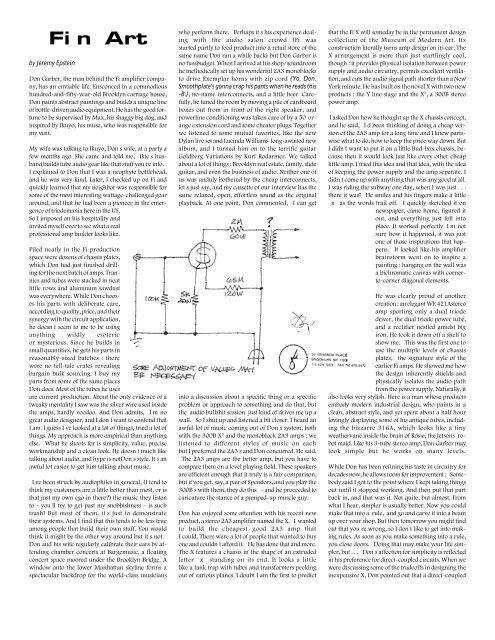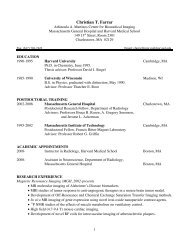the magazine of astounding sound
the magazine of astounding sound
the magazine of astounding sound
Create successful ePaper yourself
Turn your PDF publications into a flip-book with our unique Google optimized e-Paper software.
Fi‘n’ Art<br />
by Jeremy Epstein<br />
Don Garber, <strong>the</strong> man behind <strong>the</strong> Fi amplifier company,<br />
has an enviable life. Ensconced in a commodious<br />
hundred-and-fifty-year-old Brooklyn carriage house,<br />
Don paints abstract paintings and builds a unique line<br />
<strong>of</strong> bottle-driven audio equipment. He has <strong>the</strong> good fortune<br />
to be supervised by Max, his shaggy big dog, and<br />
inspired by Ikuyo, his muse, who was responsible for<br />
my visit.<br />
My wife was talking to Ikuyo, Don’s wife, at a party a<br />
few months ago. She came and told me, “Ikie’s husband<br />
builds tube audio gear like that stuff you’re into.”<br />
I explained to Don that I was a neophyte bottlehead,<br />
and he was very kind. Later, I checked up on Fi and<br />
quickly learned that my neighbor was responsible for<br />
some <strong>of</strong> <strong>the</strong> most interesting wattage-challenged gear<br />
around, and that he had been a pioneer in <strong>the</strong> emergence<br />
<strong>of</strong> triodemania here in <strong>the</strong> US.<br />
So I imposed on his hospitality and<br />
invited myself over to see what a real<br />
pr<strong>of</strong>essional amp builder looks like.<br />
Piled neatly in <strong>the</strong> Fi production<br />
space were dozens <strong>of</strong> chassis plates,<br />
which Don had just finished drilling<br />
for <strong>the</strong> next batch <strong>of</strong> amps. Trannies<br />
and tubes were stacked in neat<br />
little rows and aluminum sawdust<br />
was everywhere. While Don chooses<br />
his parts with deliberate care,<br />
according to quality, price, and <strong>the</strong>ir<br />
synergy with <strong>the</strong> circuit application,<br />
he doesn’t seem to me to be using<br />
anything wildly esoteric<br />
or mysterious. Since he builds in<br />
small quantities, he gets his parts in<br />
reasonably-sized batches : <strong>the</strong>re<br />
were no tell-tale crates revealing<br />
bargain bulk sourcing. I buy my<br />
parts from some <strong>of</strong> <strong>the</strong> same places<br />
Don does. Most <strong>of</strong> <strong>the</strong> tubes he uses<br />
are current production. About <strong>the</strong> only evidence <strong>of</strong> a<br />
tweaky mentality I saw was <strong>the</strong> silver wire used inside<br />
<strong>the</strong> amps, hardly voodoo. And Don admits, “I’m no<br />
great audio designer, and I don’t want to contend that<br />
I am. I guess I’ve looked at a lot <strong>of</strong> things, tried a lot <strong>of</strong><br />
things. My approach is more empirical than anything<br />
else.” What he shoots for is simplicity, value, precise<br />
workmanship and a clean look. He doesn’t much like<br />
talking about audio, and hype is notDon’s style. It’s an<br />
awful lot easier to get him talking about music.<br />
”I’ve been struck by audiophiles in general, (I tend to<br />
think my customers are a little better than most, or is<br />
that just my own ego in <strong>the</strong>re?) <strong>the</strong> music <strong>the</strong>y listen<br />
to - you’ll try to get past my snobbishness - is such<br />
trash! But most <strong>of</strong> <strong>the</strong>m, it’s just to demonstrate<br />
<strong>the</strong>ir systems. And I find that this tends to be less true<br />
among people that build <strong>the</strong>ir own stuff. You would<br />
think it might be <strong>the</strong> o<strong>the</strong>r way around but it’s not.”<br />
Don and his wife regularly calibrate <strong>the</strong>ir ears by attending<br />
chamber concerts at Bargemusic, a floating<br />
concert space moored under <strong>the</strong> Brooklyn Bridge. A<br />
window onto <strong>the</strong> lower Manhattan skyline forms a<br />
spectacular backdrop for <strong>the</strong> world-class musicians<br />
who perform <strong>the</strong>re. Perhaps it’s his experience dealing<br />
with <strong>the</strong> audio salon crowd (Fi was<br />
started partly to feed product into a retail store <strong>of</strong> <strong>the</strong><br />
same name Don ran a while back) but Don Garber is<br />
no fussbudget. When I arrived at his shop/<strong>sound</strong>room<br />
he methodically set up his wonderful 2A3 monoblocks<br />
to drive Exemplar horns with zip cord (Yo, Don,<br />
Smoothplate’s gonna crap his pants when he reads this<br />
-B.), no-name interconnects, and a little beer. Carefully,<br />
he tuned <strong>the</strong> room by moving a pile <strong>of</strong> cardboard<br />
boxes out from in front <strong>of</strong> <strong>the</strong> right speaker, and<br />
powerline conditioning was taken care <strong>of</strong> by a 50' orange<br />
extension cord and some cheater plugs. Toge<strong>the</strong>r<br />
we listened to some mutual favorites, like <strong>the</strong> new<br />
Dylan live set and Lucinda Williams’ long-awaited new<br />
album, and I turned him on to <strong>the</strong> terrific guitar<br />
Goldberg Variations by Kurt Rodarmer. We talked<br />
about a lot <strong>of</strong> things : Brooklyn real estate, family, slide<br />
guitar, and even <strong>the</strong> business <strong>of</strong> audio. Nei<strong>the</strong>r one <strong>of</strong><br />
us was unduly bo<strong>the</strong>red by <strong>the</strong> cheap interconnects,<br />
let’s just say, and my cassette <strong>of</strong> our interview has <strong>the</strong><br />
same relaxed, open, effortless <strong>sound</strong> as <strong>the</strong> original<br />
playback. At one point, Don commented, “I can get<br />
into a discussion about a specific thing or a specific<br />
problem or approach to something and do that, but<br />
<strong>the</strong> ‘audio bullshit session’ just kind <strong>of</strong> drives me up a<br />
wall.” So I shut up and listened a bit closer. I heard an<br />
awful lot <strong>of</strong> music coming out <strong>of</strong> Don’s system, both<br />
with <strong>the</strong> 300B X 3 and <strong>the</strong> monoblock 2A3 amps : we<br />
listened to different styles <strong>of</strong> music on each<br />
but I preferred <strong>the</strong> 2A3’s and Don concurred. He said,<br />
“The 2A3 amps are <strong>the</strong> better amp, but you have to<br />
compare <strong>the</strong>m on a level playing field. These speakers<br />
are efficient enough that it truly is a fair comparison,<br />
but if you get, say, a pair <strong>of</strong> Spendors, and you play <strong>the</strong><br />
300B’s with <strong>the</strong>m, <strong>the</strong>y do this” - and he proceeded to<br />
caricature <strong>the</strong> stance <strong>of</strong> a pumped-up muscle guy.<br />
Don has enjoyed some attention with his recent new<br />
product, a stereo 2A3 amplifier named <strong>the</strong> X. “I wanted<br />
to build <strong>the</strong> cheapest good 2A3 amp that<br />
I could. There were a lot <strong>of</strong> people that wanted to buy<br />
one and couldn’t afford it.” He has done that and more.<br />
The X features a chassis in <strong>the</strong> shape <strong>of</strong> an extruded<br />
letter “x” standing on its end. It looks a little<br />
like a tank trap with tubes and transformers peeking<br />
out <strong>of</strong> various planes. I doubt I am <strong>the</strong> first to predict<br />
that <strong>the</strong> Fi X will someday be in <strong>the</strong> permanent design<br />
collection <strong>of</strong> <strong>the</strong> Museum <strong>of</strong> Modern Art. Its<br />
construction literally turns amp design on its ear. The<br />
X arrangement is more than just startlingly cool,<br />
though : it provides physical isolation between power<br />
supply and audio circuitry, permits excellent ventilation,<br />
and cuts <strong>the</strong> audio signal path shorter than a New<br />
York minute. He has built on <strong>the</strong> novel X with two new<br />
products : <strong>the</strong> Y line stage and <strong>the</strong> X 3 , a 300B stereo<br />
power amp.<br />
I asked Don how he thought up <strong>the</strong> X chassis concept,<br />
and he said, “I’d been thinking <strong>of</strong> doing a cheap version<br />
<strong>of</strong> <strong>the</strong> 2A3 amp for a long time and I knew partswise<br />
what to do, how to keep <strong>the</strong> price way down. But<br />
I didn’t want to put it on a little Bud-box chassis, because<br />
<strong>the</strong>n it would look just like every o<strong>the</strong>r cheap<br />
little amp. I tried this idea and that idea, with <strong>the</strong> idea<br />
<strong>of</strong> keeping <strong>the</strong> power supply and <strong>the</strong> amp seperate. I<br />
didn’t come up with anything that was any good at all.<br />
I was riding <strong>the</strong> subway one day, when I was just . . .<br />
<strong>the</strong>re it was!” He smiles and his fingers make a little<br />
“x” as <strong>the</strong> words trail <strong>of</strong>f. “I quickly sketched it on<br />
newspaper, came home, figured it<br />
out, and everything just fell into<br />
place. It worked perfectly. I’m not<br />
sure how it happened, it was just<br />
one <strong>of</strong> those inspirations that happens.”<br />
It looked like his amplifier<br />
brainstorm went on to inspire a<br />
painting : hanging on <strong>the</strong> wall was<br />
a bichromatic canvas with cornerto-corner<br />
diagonal elements.<br />
He was clearly proud <strong>of</strong> ano<strong>the</strong>r<br />
creation : an elegant WE 421Astereo<br />
amp sporting only a dual triode<br />
driver, <strong>the</strong> dual triode power tube,<br />
and a rectifier nestled amidst big<br />
iron. He took it down <strong>of</strong>f a shelf to<br />
show me. “This was <strong>the</strong> first one to<br />
use <strong>the</strong> multiple levels <strong>of</strong> chassis<br />
plates,” <strong>the</strong> signature style <strong>of</strong> <strong>the</strong><br />
earlier Fi amps. He showed me how<br />
<strong>the</strong> design inherently shields and<br />
physically isolates <strong>the</strong> audio path<br />
from <strong>the</strong> power supply. Naturally, it<br />
also looks very stylish. Here is a man whose products<br />
embody modern industrial design, who paints in a<br />
clean, abstract style, and yet spent about a half hour<br />
lovingly displaying some <strong>of</strong> his antique tubes, including<br />
<strong>the</strong> bizzarre 316A, which looks like a tiny<br />
wea<strong>the</strong>rvane inside <strong>the</strong> brain <strong>of</strong> Rosie, <strong>the</strong> Jetsons’ robot<br />
maid. Like his 3-tube stereo amp, Don Garber may<br />
look simple but he works on many levels.<br />
While Don has been refining his taste in circuitry for<br />
decades now, he allows room for improvement : “Somebody<br />
said I got to <strong>the</strong> point where I kept taking things<br />
out until it stopped working. And <strong>the</strong>n put that part<br />
back in, and that was it. Not quite, but almost. From<br />
what I hear, simpler is usually better. Now you could<br />
make that into a ‘rule,’ and go and carve it into a beam<br />
up over your shop. But <strong>the</strong>n tomorrow you might find<br />
out that you’re wrong, so I don’t like to get into making<br />
rules. As soon as you make something into a rule,<br />
you close doors.” Doing that may make your life simpler,<br />
but . . .” Don’s affection for simplicity is reflected<br />
in his preference for direct-coupled circuits. When we<br />
were discussing some <strong>of</strong> <strong>the</strong> trade<strong>of</strong>fs in designing <strong>the</strong><br />
inexpensive X, Don pointed out that a direct-coupled







